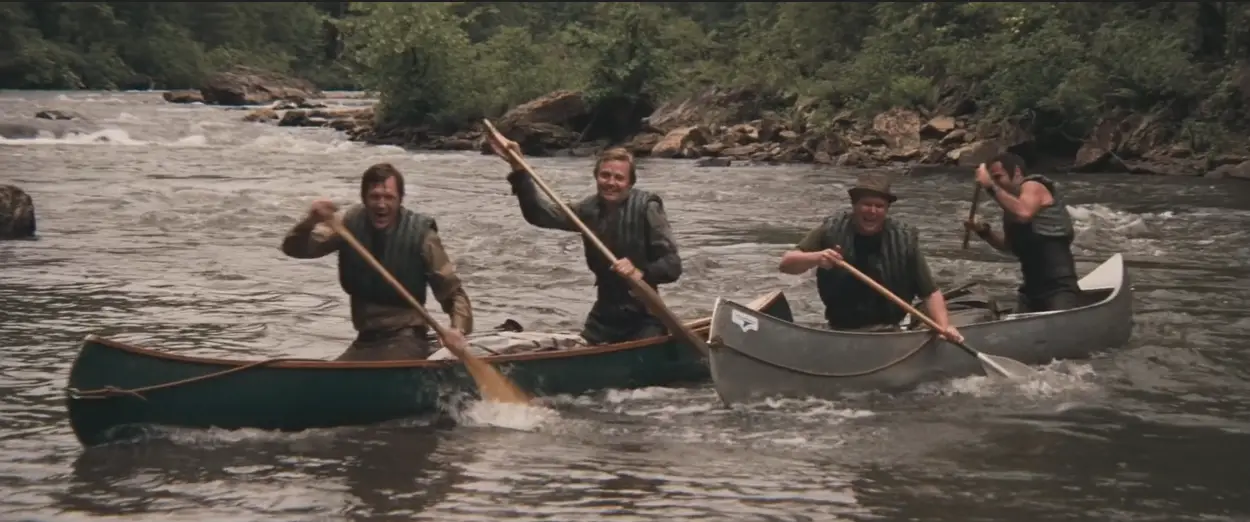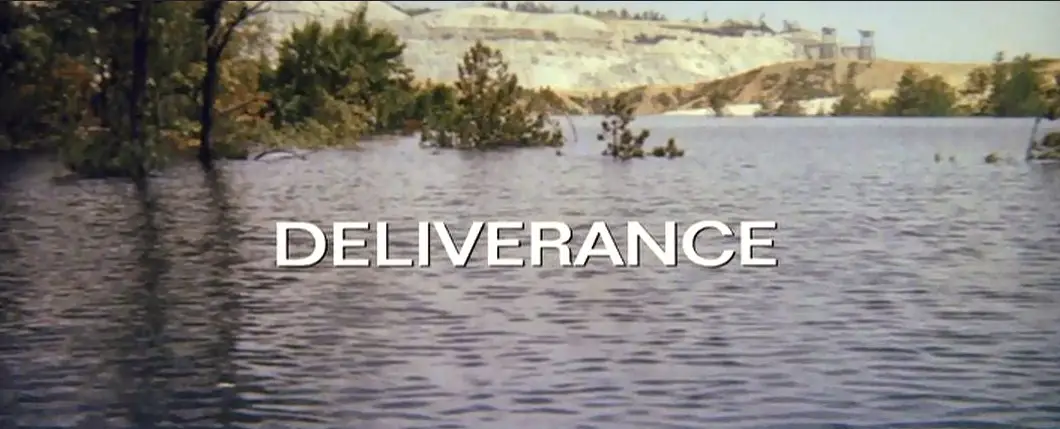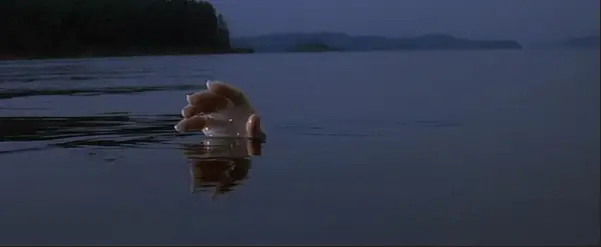
Director: John Boorman
Producer: John Boorman (Elmer, Warner Bros.)
Writers: James Dickey (novel), James Dickey and John Boorman (screenplay)
Photography: Vilmos Zsigmond
Music: Eric Weissberg
Cast: Jon Voight, Burt Reynolds, Ned Beatty, Ronny Cox, Ed Ramey, Billy Redden, Seamon Glass, Randall Deal, Bill McKinney, Herbert Coward, Lewis Crone, Ken Keener, Johnny Popwell, John Fowler, Kathy Rickman
![]()
Introduction
Deliverance is a film that punches you in the gut early and doesn’t let the feeling go away. It’s the kind of movie that makes you want to take a shower afterward — unless you’re watching it as a Psycho double feature. Indeed, the cultural reaction to Deliverance in the early ’70s was similar to the reaction to Psycho in the early ’60s, both Best Picture nominees that shook up audiences, only this time our squeamishness stemmed from a horrific “squeal like a pig” sodomy rape scene that, along with the film’s “Dueling Banjos” theme, entered straight into pop culture lore.
Yet for all the film’s cultural impact, I’ve showed it to younger folks who left scratching their heads. How can ’70s viewers deem it a masterpiece by British director John Boorman, while younger viewers deem it simply a “bore man?” This reaction only proves the point that most modern adventure films lack Boorman’s level of theme and craftsmanship. When you get down to it, Deliverance is really an art film disguised as an adventure flick. So for those who remember Deliverance as that cheap river movie with the weird redneck rape scene, look again. You’ll come to realize — from the opening voiceover to the final shot — that you missed a much more involved film than you first thought, a film that carries a depth of theme to match its pop culture reputation.
![]()
Plot Summary
Based on James Dickey’s best-selling novel about a river voyage like Joseph Conrad’s Heart of Darkness, the film follows four suburban men — fathers, salesmen, men of the modern “system” — and their decision to spend a weekend canoeing “the last wild, untamed, unpolluted, unf*cked-up river in the South,” the Cahulawassee. Their catalyst: the construction of a dam, which in a few weeks will drown the surrounding landscape and wash from existence the entire river and the hick town of Aintry.
The four men vary in temperament. There’s Lewis, the bow hunter with a “survival” patch on his leather jacket, admitting he wishes civilization would collapse back into its primal nature (played by ex-stuntman Burt Reynolds taking his first major role after Brando, Stewart and Fonda declined because of the part’s physical risk). There’s Bobby (Ned Beatty), a chubby frat-type who immediately goes to work making fun of the locals in demonstrating his own lack of moral imagination. There’s Drew (Ronny Cox), a kumbayah guitar player who has great respect for the law. Finally, there’s the film’s protagonist, Ed (Jon Voight), who’s content with life, trying to enjoy this outdoor vacation.
One-by-one, these men fail to enter this new environment. Lewis drives into a dead-end; Bobby is reproached by a local who says, “Who don’t know nothin’;” Drew is unable to keep pace with an inbred boy’s banjo-playing; and Ed’s hands shake while trying to shoot a deer. As they make their missteps, it’s clear to viewers that this peaceful river ride will ultimately transform into a hellacious test of survival skills and a battle for both their lives and their souls.

![]()
Rape of Nature
It should be no surprise then that Bobby is the first victim. Unlike the coming flood, he is the most shallow, not to mention the most reliant on the modern system, saying to himself, “I do baptize thee now in the name of modern technology.” His sins against nature make him the first victim of the wilderness, violated by a mountain man (Bill McKinney) in a horrific rape scene.
Such thematic ironies are not coincidental. Rather, they are the careful construction of a masterful filmmaker, Boorman, who inserts his consistent world view of nature trumping civilization. This plays out in both Boorman’s directing and screenwriting, as he wrote about 90% of the script, while generously giving Dickey the screen credit.
You’ll note that Lewis offers Bobby a warning via voiceover during the opening credits: “You just push a little more power into Atlanta, a little more air-conditioners for your smug little suburb, and you know what’s gonna happen? We’re gonna rape this whole god-damned landscape. We’re gonna rape it!”
It’s stuff like this that you don’t exactly catch the first time, but the meaning is plain as day on repeat viewings — modern humanity, represented by these suburban men, has long raped nature of its original state, and it’s this same nature (the river) that’s ultimately going to pay humanity back.
![]()
Director: Lord & Savior
Shooting on location in Rabun County, Georgia, along the Chattoga River, Boorman earned an Oscar nomination for metaphorically bringing his “rape of nature” themes to pass.

In the opening minutes, he gives several quiet, serene shots of the clean wilderness, as it was before the presence of man, and then interrupts these shots with roaring vehicles tearing across the screen and penetrating this natural state. This idea is reinforced soon after in the windshield reflection of tree branches and leaves as Lewis speeds through the forest, penetrating nature in reckless abandon.

This framework becomes increasingly claustrophobic the further they get down the river, as Boorman focuses his attention on each man’s psychology. The biggest spiritual journey belongs to Ed, who begins with a sort of terminal complacency, saying, “No one can find us up here.” Throughout his “deliverance” journey down the river, he learns that “sometimes you have to lose yourself before you can find anything,” a Biblical reference to Matthew 10:39, where Jesus said: “He who finds his life will lose it, and he who loses his life for My sake will find it.”
Indeed, Ed undergoes a huge transformation, moving from his inability to kill a deer to his ability to kill a man if the game of survival so requires. As Lewis tells Ed, “Now you get to play the game.” Boorman suggests that in life, this game is in the hands of The Creator, and we are all but pawns in His game. On screen, this game is in the hands of the film’s creator, the director Boorman, whose characters are pawns in his magnificent artwork.
Ed’s psychological study culminates with his escape from the river and his return to civilization. This sets up a dinner scene which casual viewers may find boring compared to the river-rapids action, but which engaged viewers will realize is the film’s most importance scene. It is here that Ed realizes there’s no turning back. He’s eating a homecooked meal, the very object of his former contentment, but now can’t help bursting into tears, realizing the river trip has forever changed him and that he can no longer feel the contentment he had before.
Boorman accents this with a graveyard shot of workers digging up coffins to transport before the flood. It’s a reminder of Ed’s guilt as to the dead bodies he and his friends left buried in the flood. The image of a church-on-wheels, being transported out of town, calls to mind thoughts of the film’s title: deliverance. Have our characters truly been delivered from evil, their sins washed away by the Great Flood? Or, will the events be a black mark against their souls that haunts them forever?
Boorman seems to suggest the latter, showing Ed waking up in a cold sweat to the image of a hand reaching up out of the water.

![]()
Legacy
Boorman claims the hand image had haunted him since his childhood reading of King Arthur and the Water Lady, which he himself brought to the screen as Excalibur (1981).
The image of something jumping out of the water has inspired countless iterations in the horror genre, from Jaws (1975) to Friday the 13th (1980), where the dead body of Jason emerges for a final jump scare.
The device of having a nightmare about a surprise hand was also famously used by Brian DiPalma in the final scene of Carrie (1976).
The World Wrestling Federation referenced this with the Undertaker reaching his hand out of the grave after a “Buried Alive” match.
More broadly, the themes of Deliverance directly inspired the white-river-rafting adventure thriller The River Wild (1994), starring Meryl Streep, Kevin Bacon, David Straitharn and John C. Reilly in a wildly underrated film.
Of course, nothing has been as culturally influential as the “Dueling Banjos” theme by composer Eric Weissberg. Just a few chords will instantly trigger calls of “squeal like a pig” — even by those who have never seen the movie.
Perhaps what continues to haunt us the most about Deliverance is the same thing that haunts Jon Voight’s character: the ambiguity of what exactly happened, who’s responsible for what and how much guilt is involved. Were shots fired, or was something else involved? Is a certain character a gap-toothed villain or an innocent brother-in-law? What’s the right thing to do in these situations? And is mankind’s march toward industrialization undermining the natural beauty that predated us? Boorman leaves each up to the audience for a viewing experience that lasts much longer than any rollercoaster ride down a river. Like Noah, we’re bracing for the flood, and this is our holy water.
